A Coruna city
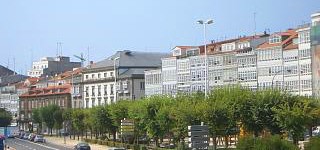
The provincial capital of A Coruna (also called Corruna in English) is a on a different scale to Pontevedra, Ourense and Lugo, Galicia's other district capitals. But that is not where the differences end, in fact it is the starting point for what we think is a very different and alternative Galician city.
A Coruna really is massive and although it has an old or medieval quarter, unlike the other Galician capitals, we think the best parts of this city are outside the main historic area.
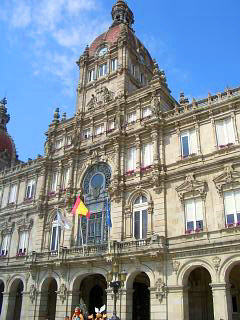
Well there is a monumental district and it contains some old churches and other buildings of interest, but few that compete with the baroque, gothic and neo-classical examples you will find in the provinces more (internationally) famous city of Santiago de Compostela.
Coruna city also has some grand squares and one, the "Maria Pita" square, is especially impressive and is overlooked by the palatial looking council offices called the municipal palace. This building (photo right) is certainly worthy of the description "monumental".
An attractive new promenade runs the length of the cities sea facing perimeter and you can walk along it as you venture in and out of the city itself. A tram system also runs up and down a significant part of the sea front and, although intended as a mode of transport, it is also ideal for sightseeing and enjoying a breeze on a hot day.
A Coruna's harbour is large and takes a multitude of vessels from commercial transporters
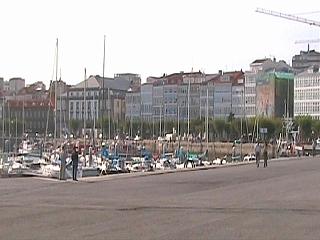 and fishing boats, to cruise liners and yachts and has non stop shipping traffic. The harbour facing buildings also add to A Coruna's appeal with their galeria style facades reaching several storeys in height and the combination of glass, white frames and structural components giving rise to the city's nick name of "crystal or glass city". Left, a view showing one end of the city's large harbour with some of the galeria featuring buildings in the background.
and fishing boats, to cruise liners and yachts and has non stop shipping traffic. The harbour facing buildings also add to A Coruna's appeal with their galeria style facades reaching several storeys in height and the combination of glass, white frames and structural components giving rise to the city's nick name of "crystal or glass city". Left, a view showing one end of the city's large harbour with some of the galeria featuring buildings in the background.
Walking around the city also creates a different impression to that experienced in Pontevedra or Ourense. In many of Galica's towns and cities, leaving the old district frequently confronts you with a mixture of decrepit old and ugly new buildings, in A Coruna this is not the case. The whole of A Coruna seems clean and tidy and as you leave the oldest district and enter some of the newer areas the architectural theme of galerias (glass enclosed balconies) really takes hold of the city and gives it a unique and distinctive feel.
A Coruna - a city of contrasts
The combination of old and new continues with two of A Coruna's biggest sight seeing draws. On the one hand the city has the worlds oldest operational lighthouse, "la Torre de Hercules", which dates back to Roman times, but equally this is contrasted with the
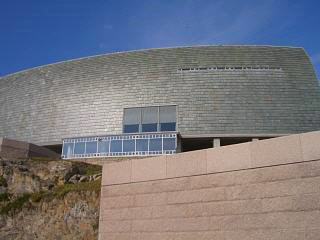 futuristic "Domus" building (below), both of which are sited overlooking the ocean. If this is not enough an old fortress, the "Castillo de San Anton" also projects out into A Coruna's harbour at the end of a small stone pier. An obvious indication of A Coruna's past defences against its many attackers and invaders.
futuristic "Domus" building (below), both of which are sited overlooking the ocean. If this is not enough an old fortress, the "Castillo de San Anton" also projects out into A Coruna's harbour at the end of a small stone pier. An obvious indication of A Coruna's past defences against its many attackers and invaders.
Exploring A Coruna city is no mean feat and each of the attractions mentioned above require some walking, or better still a trip on the tram, to see. The great thing about this city is the fact that travelling this way provides you with plenty to look at. If you are in the old quarter there is a military museum, the Galician archive or the tomb of British (Scottish really) hero Sir John Moore. If you are out and about in the newer parts of town there is plenty of shopping, but also a lively atmosphere, attractive buildings and the sea is never far from view.
Finding a single highlight for A Coruna is difficult, it is a city with lots to commend it, but the real appeal is the city as a whole and you can easily spend a full day exploring
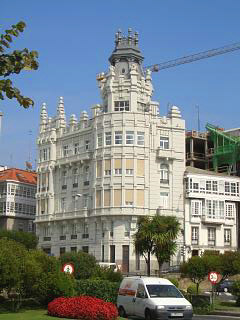 without seeing everything it has to offer. If you want to be clinical in your exploration there are, "according to the city council", three different tourist routes you can take. The first focuses on the old district, the second is themed around food and gastronomy and the final one is known as the "Picasso" route, after the artist who lived in A Coruna for a number of years. Personally we would recommend (as ever) that the best way to see this city is to follow a route that takes in all the main tourist haunts and then generally wonder – but time may be against you.
without seeing everything it has to offer. If you want to be clinical in your exploration there are, "according to the city council", three different tourist routes you can take. The first focuses on the old district, the second is themed around food and gastronomy and the final one is known as the "Picasso" route, after the artist who lived in A Coruna for a number of years. Personally we would recommend (as ever) that the best way to see this city is to follow a route that takes in all the main tourist haunts and then generally wonder – but time may be against you.
Getting information, maps and English language help is a perennial problem in Galicia, but excellent tourist information centres with multi-lingual staff (including German and French speakers) can be found throughout A Coruna and those that we spoke to seemed very knowledgeable and helpful.
One final thing that we noticed in the city of Coruna was the constant building and maintenance work that was taking place everywhere (you will see cranes in some of the photos). Most of this work appeared to be focussed on the refurbishment of the late 19th and early 20th century modernist buildings and, unlike many other Galician cities, there were few ruinous buildings to spoil the views.

